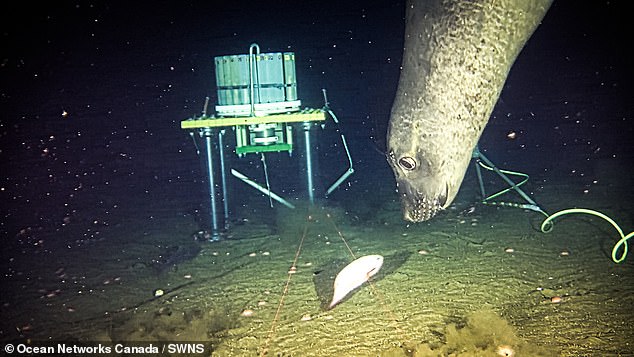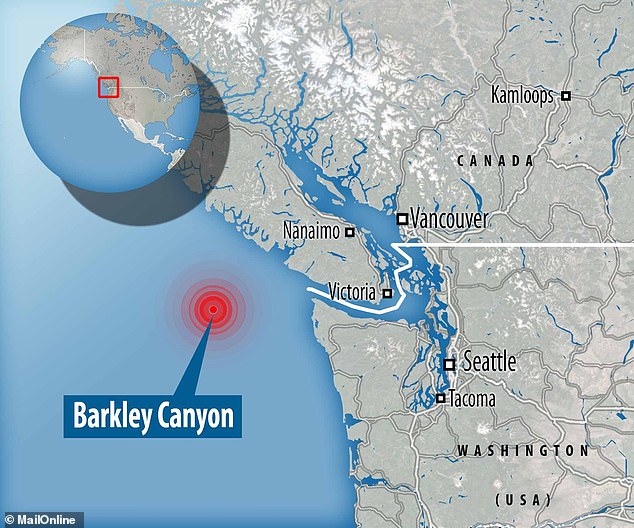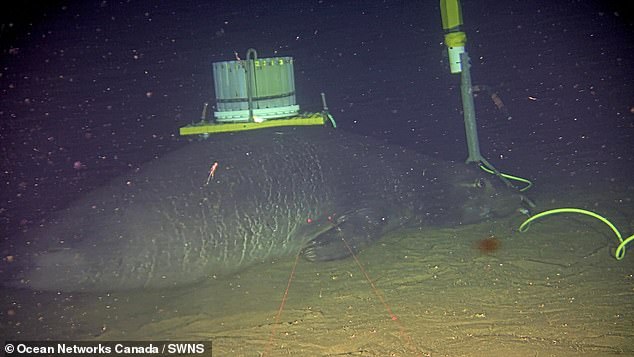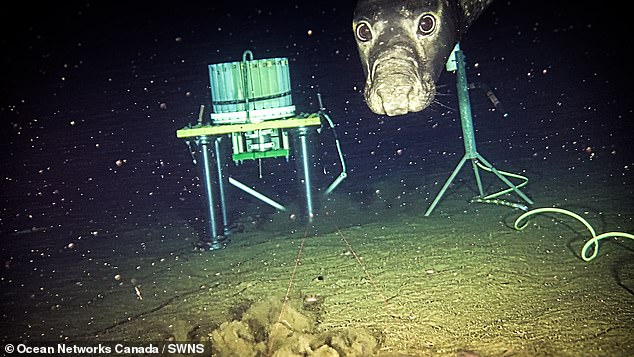Talk about good vibes! Video shows a group of cheeky seals lured to the bottom of the Pacific Ocean by sonar waves (which scientists affectionately call the Beach Boys)
A stunning video shows a group of brazen seals being lured to the bottom of the Pacific Ocean by research equipment.
Eight northern elephant seals (Mirounga angustirostris) have been filmed exploring, eating and even sleeping in a remote underwater world of Barkley Canyon, over 600 metres deep.
The naturally curious marine mammals are likely attracted by the experts’ sonar device – a technology that emits sound waves to measure distances.
Scientists became so familiar with the recurring visitors that they named them after members of the Beach Boys, including Brian Wilson and his brothers Carl and Dennis.
It is thought that the seals return to this spot again and again because the lighting from an additional camera lures the disturbed fish out of their hiding places, making it a great place for a tasty snack.
Pet Sounds: Here, “Brian” the northern elephant seal looks at the camera as he is lured by the variety of underwater equipment in Barkley Canyon

Scientists believe the seals are attracted to the sonar waves and light emitted by the underwater cameras.
Similar to the famous experiments with Pavlov’s dog, scientists think the seals associate the vibrating sound waves with food.
“We suspect that the seals have learned to associate the sonar sound of the survey instrument with the presence of food – a phenomenon known as the ‘dinner bell’ effect,” said Dr. Héloïse Frouin-Mouy, a visiting professor at the University of Victoria in British Columbia, Canada.
‘(They) may take advantage of the fish disturbed by the camera light, particularly targeting sandfish, their favourite meal, as seen in the video footage.’
Northern elephant seals – found in the eastern and central North Pacific Ocean – forage at great depths, where it is very dark even during the day.
Their eyes’ sensitivity to light is ten times greater than that of a human, but they Also use their sensitive whiskers to detect movement in the water and locate prey.
In collaboration with Ocean Networks Canada, the underwater setup was designed to study the effects of light on the behavior of fish and invertebrates along Barkley Canyon, home to beautiful deep-sea coral cliffs.
They were pleasantly surprised to see that visitors were curious when they viewed the camera images, acoustic images and sound data.
A total of at least eight male elephant seals, ranging in age from 4 to 7 years, were captured on camera and detected by hydrophones – underwater microphones.
Their names were Brian, Dennis, Carl, Mike, Al, Bruce, Blondie and David. These names refer to eight members of the Beach Boys from the various line-ups of the band.

Researchers became so familiar with the returning visitors that they named them after members of the Beach Boys

The Beach Boys in London, 1964. Clockwise from left – Al Jardine, Carl Wilson, Dennis Wilson, Brian Wilson and Mike Love

The animals made multiple visits to the 645-metre-deep Barkley Canyon research site off the west coast of British Columbia between 2022 and 2023.
The animals made multiple visits to the 645-metre-deep Barkley Canyon research site off the west coast of British Columbia between 2022 and 2023.
Repeated visits by four seals to the research site over 10 days also showed that they quickly learned to use the infrastructure and forage more efficiently, Frouin-Mouy adds.
“We became familiar with the mammals and eventually gave them names in the article, after members of the Beach Boys, to differentiate between the frequency of visits and the habits observed,” she said.
The seals were also lured with additional bait traps consisting of bottles full of sardines.
However, video observations showed that they mainly targeted actively swimming sandfish (Anoplopoma fimbria), while ignoring stationary or drifting prey.
The team also found that they produce low-frequency sounds, both voluntarily and involuntarily, while foraging for food and even take ‘power naps’ on the sea floor.

The ability of seals to repeatedly visit the same location for extended periods (more than 10 days) was due to the sound generated by the sonar equipment

The site features a high-definition camera, acoustic sonar, hydrophone, two LED lights and automatic bait release
Elephant seals are believed to feed on bottom-dwelling marine animals such as ratfish, sharks, dogfish, eels, rockfish and squid.
They spend most of their time in the open ocean – up to 5,000 miles (8,000 kilometers) from shore – and come ashore only twice a year to breed and molt.
The northern elephant seal was hunted extensively from the 18th century onwards and the species was declared extinct in 1884.
However, additional populations have been found and have been legally protected in Mexico and the US since the early 20th century.
A study describing the behavior was published in PLOS One.
